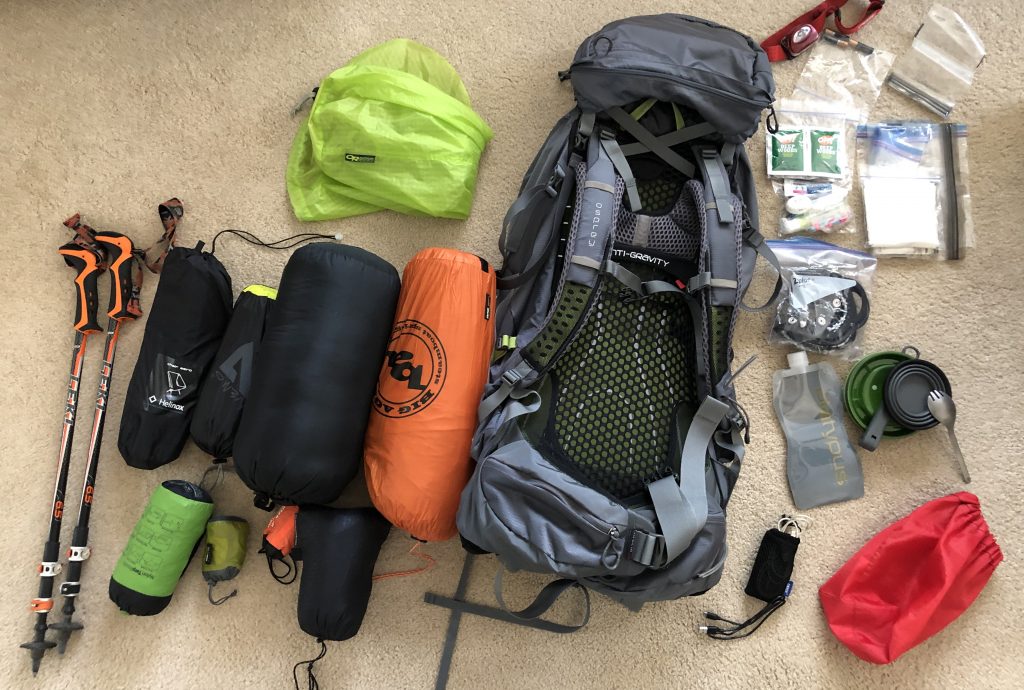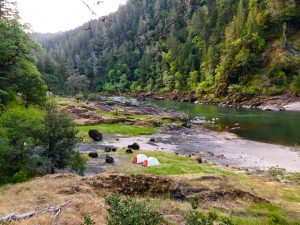
An overview of the basic equipment needed for backpacking, with insights regarding the features one should seek in backpacking equipment.
Chris & Mac
We outventure to help you outventure!
Support Grey Otter Outventures!
Please help us continue to bring you great content:
Preplanning – Check! Water, hydration, food – Check! Navigation, first aid, emergency supplies – Check! Clothing – Check! Now it’s time to examine equipment. This article is not, however, meant to be an in-depth look at particular backpacking equipment. Those articles will come later. The purpose of this article is to give the reader an overview of the basic equipment he/she will need for backpacking with general insights regarding the features one should seek in the equipment.
Backpacks
Backpacking packs come in a range of volumes, usually expressed in liters. New backpackers have a tendency to over-estimate the amount of room they will need in a pack and pick one that is too large for their needs. The issue here is weight. Although the pack can be synched to deal with the extra volume, that volume means additional pounds. Since we cannot all afford to have a range of packs, try to be realistic about how many days your trips will average and the associated volume, then pick a pack that will just fit your requirements. You may need to give up some creature comforts on longer trips, but you will be happy on the bulk of your trips you are not carrying the extra weight.
When you pick your pack, make sure it fits properly. Although you may be able to get away with a poorly fitting day pack on day hikes, on a multi-day backpacking trip, a poorly fitting pack can become a real problem. Any good outfitter will be able to properly fit you. If you want to buy the pack online, there are a lot of resources available to guide you in proper fit, so do your homework.
It is critical to make sure your chosen pack will support the load you plan to carry, so load the pack while still in the return period to make sure it fits properly when loaded and supports the weight on your hips and shoulders. When you load your pack, make sure to distribute the weight to prevent uneven stress on your muscles. If the pack is supporting the weight properly, you should feel about 65% of the weight on your hips.
In terms of pack features, you should try to go with the minimum features you believe the pack needs for your purposes. Features, such as numerous storage pockets and detachable day packs, mean extra weight. If you really don’t need the feature, don’t get that model. We cannot stress this enough – weight counts! A cautionary point here, however. There are many ultra-light packs on the market. To keep them light, manufacturers use light materials and minimal support. Aside from durability issues, minimal support can be a problem, particularly for older hikers with bad backs and knees. So, get the lightest pack you can get while ensuring it provides the support and durability you need for your intended use and body strength.
Backpacking Tents
Remember, you are not car camping! Forget about big, luxurious tents for backpacking. More luxury comes with a big penalty – weight. Your goal should be to get a quality backpacking tent that is the lightest you can afford. What matters most is the tent is light, just big enough for your need, easy to set-up, stable in the wind, and doesn’t leak. Beyond that, everything else is a luxury.
There are so many tents, tent features, and tent materials out there that a full article can be written examining the options (something we will do later as our website develops). This is not the place for that examination, but we do want to make a point about tent size. Many couples, ourselves included, think that getting a 2 or 3 person tent is the way to go, then distributing the parts and weight based on our strength. Because we often take our dog backpacking, we selected an ultra-light 3 person tent. Our thinking was this would give us enough room for us, the dog, and our gear in its 2 vestibules. It did, but it came at a price – extra weight for one of us, difficulty finding level spots that can accommodate the footprint of the tent (remember, this is backcountry camping and level is hard to come by!), and the tendency to slide into each other during the night due to unlevel ground. Don’t get us wrong, the tent is awesome, but it just didn’t work for our needs.
We now use individual one person ultralight tents for backpacking, just big enough to fit one person and a dog, with a single vestibule for gear. Although it meant we had to distribute the equipment weight a little differently to compensate Mac for picking up an extra 9 ounces, this approach is working beautifully and all get a good night sleep – which is important when you are packing on the miles hiking. We are not saying this is the best approach for everyone, and it certainly increases backpacking equipment costs, but it is a consideration you should be aware of when you choose your tent.
Sleeping Bags
There are many sleeping bags on the market. You want a backpacking sleeping bag. Bags designed for car camping are very heavy and not appropriate for backpacking. Backpacking bags tend to be less luxurious than those for car camping (although high end down bags can be very comfortable). What is important is first and foremost, thermal qualities.
If you are not going to have multiple bags, pick a bag that is in the mid-range of temperatures you will sleep. If it is colder than the bag’s rating, within reason, you can add clothing layers. If it is warmer, you can unzip the bag or sleep on top. Also make sure the bag is comfortable. Most backpacking bags are mummy style to save weight and provide higher thermal qualities, but a number of manufactures make over-sized mummys if you like a roomier bag. (Just realize that roomer adds weight.)
Regarding insulation, bags use either down or synthetic stuffing. Synthetic is cheaper, but adds weight and provides less warmth. Note that you may come across concerns that down looses thermal qualities if it gets wet. This is true, however, quality down bags have a coating which addresses this issue. Also note that not all down is the same. Goose down has better thermal qualities (again, weight) than duck down, but it is definitely more expensive.
Personally, we chose to go with goose down, ultralight bags. They come with a price, but it is worth it to us to shed weight and still get a good night sleep. Weigh the options for yourself and make the best choice in light of your personal situation.
Sleeping Pads
Are good! Sleeping on the hard ground without a pad, particularly for more than one night, will bend you and twist you into a pretzel. There may be young stud and studesses out there who can handle this for extended trips, but not us old folks. Fortunately, there are a wide variety of sleeping pads out there to solve the problem.
Backpacking sleeping pads vary in style, size, materials, thermal qualities, and price. What is important here is you get the smallest and lightest pad you will be comfortable sleeping on. If you are only going to have one pad, pick one with a mid-range thermal quality. Also pay attention to the materials. Some pads are very noisy and/or slippery (which can be a problem if you are not on level ground). Do your homework, read reviews, and pick the best pad for your needs and budget. Your back will thank you!
Cooking Equipment
There are lots of stove options out there for cooking. Some have refillable fuel cylinders, while others use disposable propane tanks or enable the use of twigs to generate heat. Most require the use of a pot or pans, although there are some models that are set-up strictly to boil water in a large cup that is part of the system. Within all this, your weight penalty will vary widely.
It is true that titanium pots are light and can be used with an ultralight stove, but you end up with roughly the same weight as a boil system which has an incorporated cup. The difference is you can cook in the pot, rather than simply boiling water to re-hydrate your food. Anything other than these two approaches will be heavier to carry, but will afford you the ability to prepare more complicated meals.
Personally, we decided to go with a boil system. Everything we need is encompassed in the system as one unit for a 15.5 oz. We select foods that we can re-hydrate on the trail and either buy them dehydrated or dehydrate them ourselves. We also use instant coffee packets. All we need for cooking is a fuel canister and water. This system works great for our needs and keep the weight of our cooking system to a bare minimum, but it may not be your preference, so look at the options out there and decide which meets your needs at the lowest weight.
Eating Tools
You can get into plates, bowls, and multi-silverware systems, but this will add weight even if these things are made from titanium. Some people want the luxury they afford, others, like us, want minimum weight. We use a collapsible bowl to re-hydrate our food and a titanium spork (combination spoon and fork). Additionally, we use an ultra-light collapsible cup for coffee and other beverages. This gives us the basic eating tools we need with a minimum weight penalty. Shop around and find the best system for you given your culinary designs and need for creature comforts.
Backpacking Camp Chairs
A luxury item, but one that many of us over 40 view as a necessity! Sitting on the ground day after day can become a problem, particularly for older backpackers. A number of options exist to address this problem ranging from blow up cushions to full blown camp chairs made for backpacking. Each carries a different weight penalty, but it is even possible to get a respectable camp chair that weighs only a pound.
We have pads, ultralight chairs weighing a pound, and light weight chairs weighing 2.5 lbs. We select what we will carry, if anything, based on the conditions we will face, the mileage we will cover, and the trip duration. Sometimes it is just not worth taking the weight penalty, such as when you have to carry a 3 lbs bear keg (see below), while at other times a chair is just the right luxury item to make your in-camp time great.
Backpacking Food Protection
There are a variety of systems available to deal with bears and rodents accessing your food. Most are quite heavy. A bear keg usually weighs in at 3+ lbs. Lighter systems are available, but may not be permitted in the area you are hiking. Always check food storage requirements before you go. If your budget allows multiple systems, choose the one with the minimum size and weight for the area you are packing. If not, select a system that covers the range of trip possibilities you anticipate.
Trekking Poles
They are awesome! We never used them until we started backpacking, because we did not understand the benefit. Now we use them on almost all our hikes. Especially for us older folks, trekking poles can make hiking all the more enjoyable.
First, when used properly, hiking poles transfer as much 40% of your weight off your legs and hips and onto your upper body, allowing less leg and foot fatigue. They also keep your posture more upright, which is better for your back and will enable you to hike longer. Additionally, they are a great assist on the uphills and can be a knee saver on the downhills. Finally, they come in very handy for balance when crossing streams or hiking over rocks.
We highly recommend anyone over 40 uses a pair of trekking poles when hiking in general, but we view them as a necessity when backpacking!
Gadgets and Gizmos
If you look around, you will find gadgets and gizmos for almost any use. These things look useful, and they are, but they add weight and are often not necessary. Don’t let yourself be lured into thinking “that will be great on my trips”. Often, you will wish you never carried it.
Ultralight Backpacking Equipment
We a committing a section to this topic because it matters. Manufactures keep making newer, lighter, ultralight backpacking equipment. It’s not a gimmick. The weight matters a lot on the trail. Done right, you can shed 10 or more pounds from your pack. It doesn’t take much imagination to understand the beauty of carrying 10 less pounds over a 10 mile day of hiking.
The downside to ultra-light backpacking equipment is that lighter weight often comes with a hefty price tag. It’s worth it, particularly for older backpackers! Personally, we look for the lightest gear we can find that meets our need. For example, we invested in ultralight down sleeping bags that allowed us to shed 2+ lbs vs non-ultralight bags with the same thermal qualities. On the other hand, we took a 1+ lbs penalty on our packs, which are still very light, over true ultralight packs because we believe the extra frame support is necessary for us at almost age 60. You will make trade-offs to get the weight down, but you want to think about the features most important to you in making your choices.
Conclusion
There is, of course, more that can be written about backpacking equipment – companies are continually releasing helpful products – but above is the basics to get you going. In future articles we will take a deeper dive into these subjects, but you now have enough to get started. Just think light, small, and useful and everything will fall into place. Happy backpacking!!
Gear We Use for Backpacking
To see descriptions of the gear Chris & Mac use for backpacking, as well as links to manufacturers and retailers offering the gear for sale, please CLICK HERE.
SAFETY DISCLAIMER: The activities discussed in this website are outdoor activities and, as such, have inherent risks to which participants are exposed. It is not the intent of this website, nor is it possible due to the variability of weather, terrain, equipment, and experience, to detail all of those risks. The information contained in this site is informational, but not instructive nor exhaustive. It is the sole responsibility of the user to ensure he/she is in good health, fully prepared, and fully informed as to dangers before undertaking any of the activities discussed in this website and the user does so at his/her own risk. The user understands that by using this website he/she acknowledges and accepts all risks associated with use of information from this website and participation in any particular activity addressed herein. Please see “Terms of Use” for additional information.
Want to share this article with your friends? Click on the share button below:
Want more?
Get the latest outventure updates by following us on social media . . .



